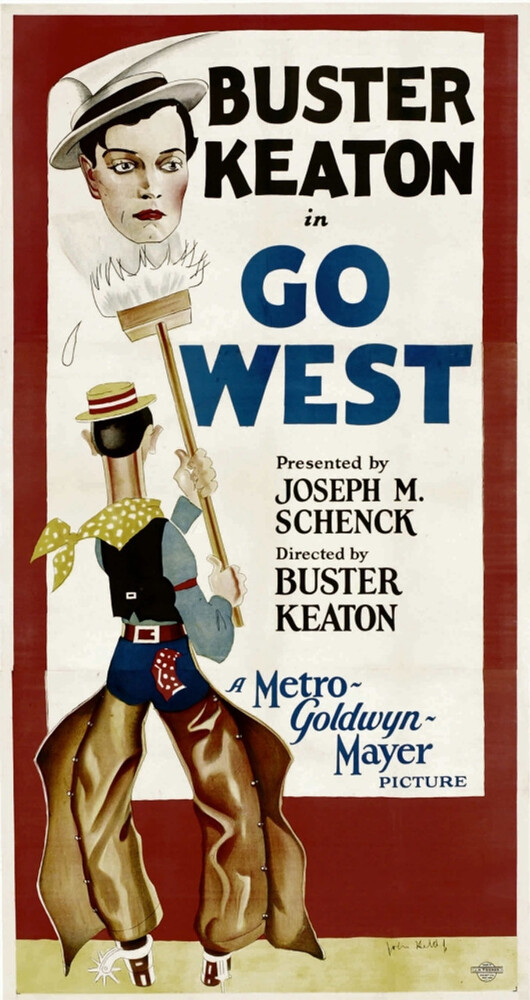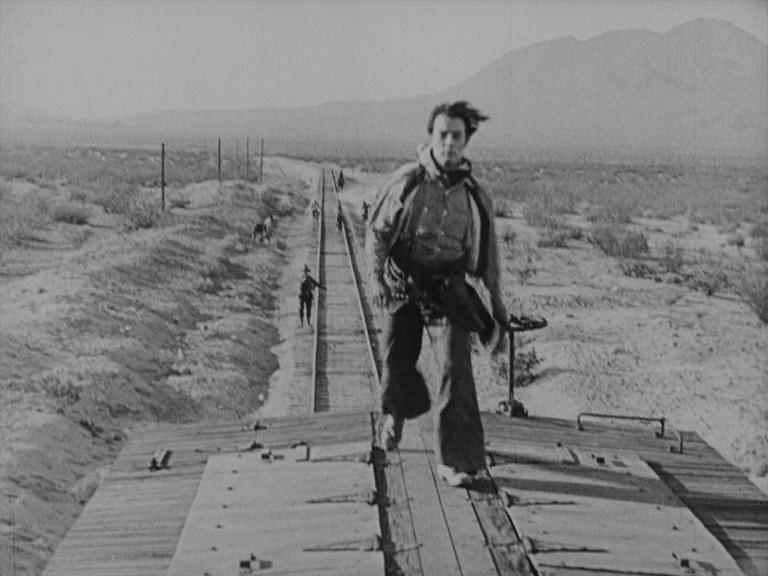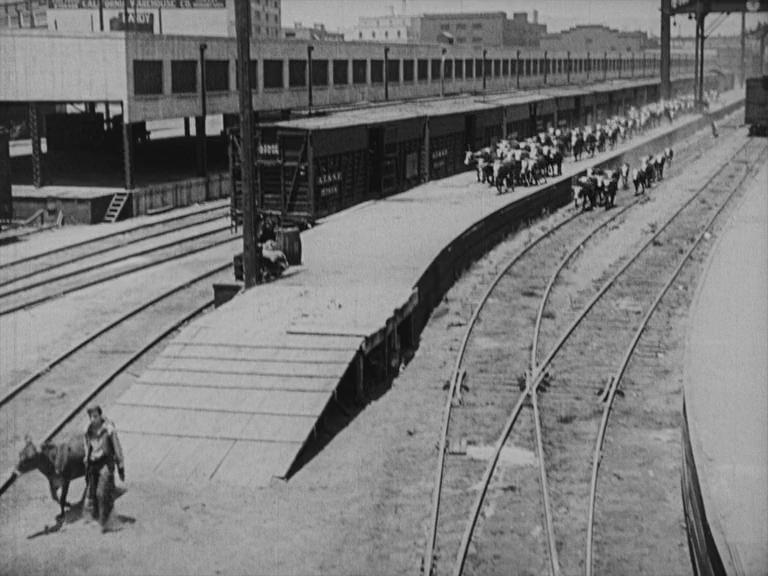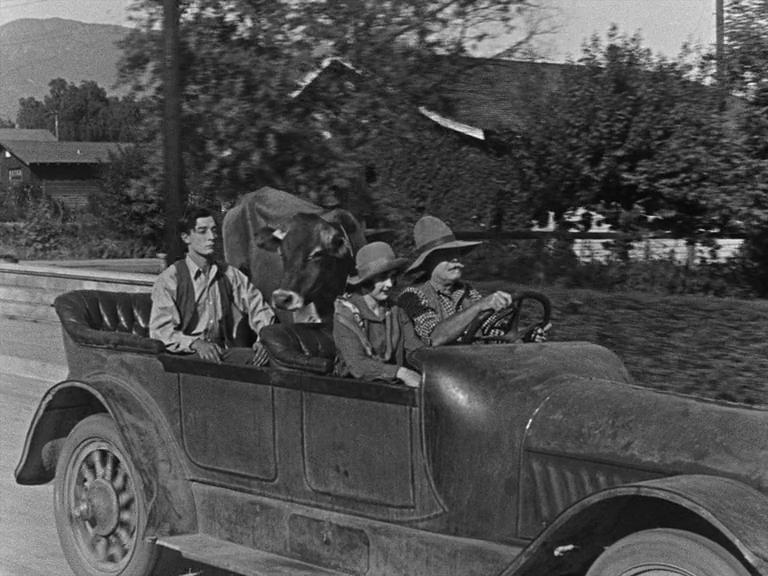Director: Buster Keaton
Writers: Buster Keaton and Lex Neal, from a scenario by Raymond Cannon
Star: Buster Keaton
 |
Index: That's a Wrap!
The second of Buster Keaton’s two features for 1925, Go West is a far more subtle film than Seven Chances, or indeed any of his earlier full length films. I’m used to suggesting words like “frantic”, “acrobatic” and “impressive”. None of those spring to mind here. I’d offer “slow”, “calm” and “gentle”, at least until the finalé.
That finalé involves Buster dressed in red as a devil to lead a herd of cows through the city of Los Angeles to the stockyards. It reminds a great deal of the finalé to Seven Chances, where his pursuers were would-be brides—a different meat market, I guess—but it’s initially slower, gaining pace only when he finds the costume.
Until then, it’s gentle comedy performed at a gentle pace, the best scene the first one, still in the east. Buster plays Friendless, the credits tell us, and it’s a fair name. The shopkeeper he meets as we start certainly isn’t his friend and neither is anyone else at any point in the film. Well, except Brown Eyes, who plays herself.
 |
He’s in Indiana when we begin but about to move on again, so he walks his bed over to the general store and sells it and everything on it for a measly $1.65. He collects his toiletries out of a drawer, only to be sold them back, even a photo of his mum. After he buys sausage and bread and a charity girl literally takes his last nickel, he’s sold everything for a sandwich.
We know where he’s going to end up but it’s the Big Apple first. He chooses his destinations from the names of lines on railroad cars and New York Central R.R. seems like a good pick. However, one day of struggling to navigate the pavements and he’s back at the train yards. It’s finding a purse, containing nothing useful except a tiny woman’s pistol, that prompts an manifestation of Horace Greeley to tell him to “Go west, young man, go west.” So, A.T. & S.F. it is. Atchison, Topeka & Santa Fe.
He doesn’t get to wherever it’s going as the cargo in his freight car is barrels, stacked the wrong way, and he carelessly leaves the door open, so at some point he rolls on out inside a barrel and down a hillside into the Old West.
 |
Apparently they shot the ranch scenes here in Arizona, outside Kingman, but we can’t tell because there are no reference points, just an expanse of desert and a whole lot of cows. Oh, and as he gets there, a rattlesnake, jackrabbits and cactus. It’s clearly the southwest.
And, if everything’s been relaxed thus far (a sidewalk scene in New York notwithstanding), it promptly slows down, aided by gags like the one where he tries to milk a cow by putting a bucket underneath it and waiting. When he’s asked to get a horse and join the boys, he finds a large mule and sits so far back that both he and the saddle promptly fall off.
Arguably the best gag at the ranch, which is our location for the bulk of the film, is the one where he sits down for dinner just as everyone else stands up to get back to work. He misses out on food twice, so makes sure that the third time goes differently. He races in, scarfs down food and stands as everyone else sits, a clear statement of pride that he finally made it.
 |
There’s also a running joke about his gun, as it’s so small that it almost literally gets lost in a full size holster, prompting him to tie string around it just so he can draw. There’s also the slightest of stories, something to do with this ranch owner needing to sell his cattle, while a rival rancher wants him to wait because he’s a greedy man holding out for a better price.
Mostly, though, this is about a relationship, if we can call it that. Maybe just a kinship, but one between Friendless and his first friend, an undersized cow who won’t give milk. In a take on Androcles and the Lion, he takes a rock out of her hoof, she saves him from a charging bull and they’re inseparable from that point on.
The problem is that she’s still a cow on the ranch owner’s ranch and so she’ll be rounded up with the rest to go to the slaughterhouse. If the background here is the need to sell them, the foreground is Friendless doing everything he can to save Brown Eyes from that fate.
 |
And, really, that’s it. Our Hospitality, Keaton’s previous western (hey, it’s a period piece shot in Oregon and California) was often gentle for him, but it had ten times the story and twenty times the gags, on top of the usual stuntwork. This has a friendship with a cow and, while I’m not trying to dismiss that at all, it isn’t much to hang an entire film on.
Frankly, while I enjoyed that friendship, it’s best served as a long build to a final gag. After the finalé, the cattle safely in the stockyards and the ranch saved, its owner tells Friendless he can have anything he wants. He says that he just wants her. Now, we have no doubt that he’s talking about Brown Eyes but her owner doesn’t know that. All he sees is his daughter so he takes that wish entirely the wrong way. It’s a good gag and a better conclusion to the picture, but it’s hardly a riproaring punchline worthy of a sixty minute build.
I wonder what Keaton thought going in. He directed Go West himself and wrote it too, with Lex Neal from an idea by Raymond Cannon. It wasn’t sprung on him. However, it doesn’t do most of the things we expect Keaton comedies to do, just as a matter of course.
 |
There’s no attempt to use his vast acrobatic skill, beyond the barrel rolling down a hillside. There’s little attempt to tie impeccable timing to danger, though there is one clever scene in which he successfully gets two bulls into a pen by waving a red flag at them. There’s only the finalé to get out of calm mode and that’s not as frantic as any of its obvious equivalents, the best parts of it Friendless shooing cattle out of stores while customers wildly overreact.
Instead, what we get is more akin to the sort of film that Charlie Chaplin might make. It’s a character piece about a poor man and his only friend, though Keaton makes this relationship a touching one without ever becoming overly sentimental. As almost everything comes back to this core relationship, Brown Eyes credited fourth as herself, there’s nothing left for any other actor. The ranch owner gets a little to do but the leading lady doesn’t lead anything and I’m not sure I could pick the foreman out of a lineup. It was Chaplin who would have played every part in both cast and crew if he could. It seems odd to see Keaton attempting it.
I should add that there’s a brief scene here for Roscoe Arbuckle, three years after his trio of trials led to an apology by the court but an effective blacklisting by Hollywood. As Keaton became famous in Arbuckle shorts, he happily gave his old mentor a payday.
No comments:
Post a Comment